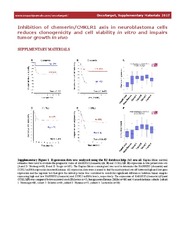| dc.contributor.author | Tümmler, Conny | |
| dc.contributor.author | Snapkov, Igor | |
| dc.contributor.author | Wickström, Malin | |
| dc.contributor.author | Moens, Ugo | |
| dc.contributor.author | Ljungblad, Linda | |
| dc.contributor.author | Elfman, Maria | |
| dc.contributor.author | Winberg, Jan-Olof | |
| dc.contributor.author | Kogner, Per | |
| dc.contributor.author | Johnsen, John Inge | |
| dc.contributor.author | Sveinbjørnsson, Baldur | |
| dc.date.accessioned | 2018-06-21T07:34:16Z | |
| dc.date.available | 2018-06-21T07:34:16Z | |
| dc.date.issued | 2017-07-27 | |
| dc.description.abstract | Pro-inflammatory cells, cytokines, and chemokines are essential in promoting a tumor supporting microenvironment. Chemerin is a chemotactic protein and a natural ligand for the receptors CMKLR1, GPR1, and CCRL2. The chemerin/CMKLR1 axis is involved in immunity and inflammation, and it has also been implicated in obesity and cancer.<p>
In neuroblastoma, a childhood tumor of the peripheral nervous system we identified correlations between high CMKLR1 and GPR1 expression and reduced overall survival probability. CMKLR1, GPR1, and chemerin RNA and protein were detected in neuroblastoma cell lines and neuroblastoma primary tumor tissue. Chemerin induced calcium mobilization, increased MMP-2 synthesis as well as MAP-kinase- and Akt-mediated signaling in neuroblastoma cells. Stimulation of neuroblastoma cells with serum, TNFα or IL-1β increased chemerin secretion. The small molecule CMKLR1 antagonist α-NETA reduced the clonogenicity and viability of neuroblastoma cell lines indicating the chemerin/CMKLR1 axis as a promoting factor in neuroblastoma tumorigenesis. Furthermore, nude mice carrying neuroblastoma SK-N-AS cells as xenografts showed impaired tumor growth when treated daily with α-NETA from day 1 after tumor cell injection.<p>
This study demonstrates the potential of the chemerin/CMKLR1 axis as a prognostic factor and possible therapeutic target in neuroblastoma. | en_US |
| dc.description.sponsorship | UiT - The Arctic University of Norway
Northern Regional Health Authority
Erna and Olav Aakre Foundation for Cancer Research
The Swedish Children's Cancer Foundation
Swedish Foundation for Strategic Research
Swedish Cancer Society
Swedish Research Council | en_US |
| dc.description | Source at <a href=https://doi.org/10.18632/oncotarget.19619> https://doi.org/10.18632/oncotarget.19619 </a>. | en_US |
| dc.identifier.citation | Tümmler, C., Snapkov, I.S., Wickström, M., Moens, U., Ljungblad, L., Elfman, L., ... Sveinbjørnsson, B. (2017). Inhibition of chemerin/CMKLR1 axis in neuroblastoma cells reduces clonogenicity and cell viability in vitro and impairs tumor growth in vivo. OncoTarget, 8(56), 95135-95151. | en_US |
| dc.identifier.cristinID | FRIDAID 1531858 | |
| dc.identifier.doi | 10.18632/oncotarget.19619 | |
| dc.identifier.issn | 1949-2553 | |
| dc.identifier.uri | https://hdl.handle.net/10037/12937 | |
| dc.language.iso | eng | en_US |
| dc.publisher | Impact Journals | en_US |
| dc.relation.ispartof | Tümmler, C. (2019). Novel Inflammatory Mediators in Neuroblastoma Tumorigenesis. (Doctoral thesis). <a href=https://hdl.handle.net/10037/17068>https://hdl.handle.net/10037/17068</a>. | |
| dc.relation.journal | OncoTarget | |
| dc.rights.accessRights | openAccess | en_US |
| dc.subject | pediatric cancer | en_US |
| dc.subject | neuroblastoma | en_US |
| dc.subject | inflammation | en_US |
| dc.subject | GPCR | en_US |
| dc.subject | chemerin | en_US |
| dc.subject | VDP::Medisinske Fag: 700::Helsefag: 800 | en_US |
| dc.subject | VDP::Medical disciplines: 700::Health sciences: 800 | en_US |
| dc.title | Inhibition of chemerin/CMKLR1 axis in neuroblastoma cells reduces clonogenicity and cell viability in vitro and impairs tumor growth in vivo | en_US |
| dc.type | Journal article | en_US |
| dc.type | Tidsskriftartikkel | en_US |
| dc.type | Peer reviewed | en_US |


 English
English norsk
norsk
